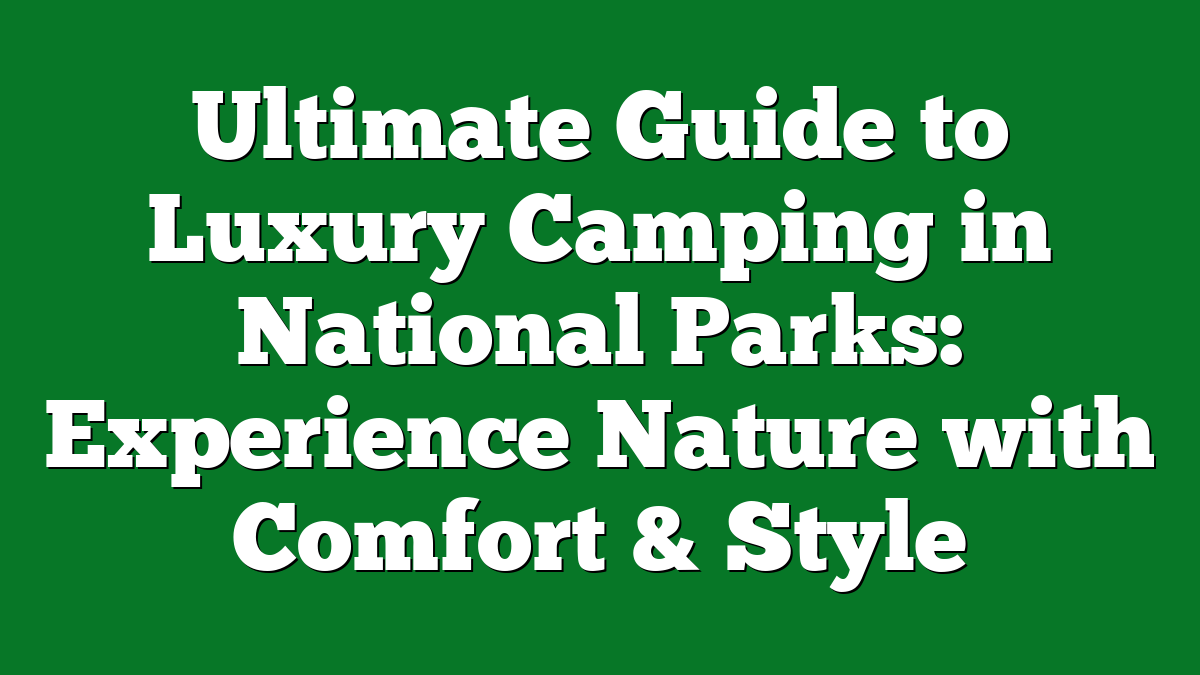Camping is one of those activities that brings us closer to nature and offers a break from our daily routines. But for those using wheelchairs, finding accessible camping spots can feel like a daunting task. I’ve discovered that with a little planning and the right resources, it’s totally possible to enjoy the great outdoors without barriers.
Overview of Accessible Camping
Accessible camping opens the door to nature for everyone, including wheelchair users. Many campsites now feature amenities designed with mobility in mind, such as wheelchair-friendly paths, accessible restrooms, and designated camping spots. It’s important to research locations ahead of time to ensure they meet specific needs.
Camping gear has also evolved to accommodate various mobility challenges. Adjustable camping chairs, tents with wide openings, and portable ramps enhance the camping experience. I always recommend checking for campsites that provide rental equipment, too, which can ease the logistics of transportation.
Accessible camping often includes scenic trails suitable for wheelchairs. Some parks feature paved trails that allow easy navigation while showcasing the beauty of the landscape. Utilizing user-friendly apps can help locate these trails, along with the amenities available at each campsite.
Moreover, community initiatives work towards increasing awareness and availability of accessible options. Organizations dedicated to outdoor inclusivity provide resources and tips for planning accessible trips, ensuring more people can connect with nature. By sharing experiences and information, we can help create a more welcoming environment for everyone.
Being part of a community that values accessibility enriches outdoor experiences. Camping, hiking, or fishing with friends and family creates lasting memories, and I encourage everyone to explore accessible options. No one should miss out on the joys of camping due to barriers.
Choosing the Right Campsite
Finding the right campsite is crucial for an enjoyable outdoor experience. My experience has shown me that accessibility features vary greatly, so taking the time to explore options makes all the difference.
Evaluating Accessibility Features
Look for campsites that offer specific accessibility features. Check if they provide wheelchair-friendly picnic tables and fire pits. Identify sites with accessible restrooms equipped with grab bars, and make sure there are well-maintained paths leading to essential areas. I often use official campsite websites and reviews to gather information on these attributes. Reach out to campground staff for insights on their accommodations.
Understanding Terrain and Environment
Assessing the terrain and environment is vital. Clear, flat ground is ideal for wheelchair users, so focus on sites with level surfaces. Investigate whether there are gravel or paved paths, as they facilitate easier navigation. Check local conditions too; muddy or rocky areas can pose challenges. I prefer to camp near natural barriers, like lakes or forests, as they often provide smoother terrain and scenic views while keeping activities enjoyable.
Essential Gear and Equipment
Planning a camping trip requires the right gear and equipment, especially for wheelchair users. Selecting suitable items enhances comfort and accessibility while enjoying the great outdoors.
Wheelchair-Friendly Tents and Shelters
Choosing the right tent makes a significant difference. Look for tents with wide entrances and ample space inside, allowing easy maneuverability. Popular options include:
- Pop-Up Tents: These tents open easily and often require minimal setup, allowing quick access.
- Ground-Level Tents: Tents designed without a raised floor provide a seamless transition from outside to inside.
- Family-Sized Tents: Tents with extra room allow for easier navigation and storage of gear.
I recommend checking for tents that come with accessible features, such as extra-large vestibules for storing gear outside the sleeping area.
Mobility Aids and Accessories
In addition to a suitable tent, having the right mobility aids and accessories enhances the camping experience. Essential items include:
- Wheelchair Tray Tables: These attach to the wheelchair, providing a stable surface for meals and activities.
- Outdoor Wheelchairs: Many designs specialize in traversing rough terrain, equipped with wider wheels and enhanced suspension.
- Accessible Camping Chairs: Lightweight and portable chairs with adjustable heights and extra-wide frames offer comfort at the campsite.
These aids not only promote independence but also help me enjoy activities like fishing or sitting around the campfire without barriers. Always consider personal needs and preferences when selecting gear to ensure a secure and enjoyable experience.
Planning Your Trip
Planning an accessible camping trip requires a bit of extra consideration, but it opens up incredible opportunities to enjoy the great outdoors. I’ve found that with careful planning, I can ensure my experience is smooth and enjoyable.
Transportation Considerations
Transportation plays a crucial role in a successful camping trip. I prioritize selecting a vehicle with enough space for a wheelchair and necessary gear. Accessible vans or SUVs provide convenience, especially when storing camping equipment. Planning a route with accessible rest stops makes a big difference. I also check for any potential obstacles or construction along the way to avoid delays. Using online maps helps identify accessible trails leading to campsites. Finding nearby parking that accommodates my needs during the trip ensures I can start my adventure with ease.
Accessibility Resources and Apps
Several resources and apps enhance my camping experience. Websites like Accessible Nature and RecAccess provide detailed information about accessible campsites and trails. I often use AllTrails, which lets me filter hiking paths based on wheelchair accessibility. Local Facebook groups and forums offer firsthand accounts from fellow campers regarding specific sites and amenities. These platforms serve as valuable assets to my planning efforts. Utilizing these tools helps me find the best accessible locations, ensuring I maximize my time in nature without unnecessary hurdles.
Tips for a Successful Camping Experience
Planning an accessible camping trip requires attention to detail and a focus on comfort and practicality. Below are specific strategies to enhance the experience for everyone involved.
Cooking and Dining Accessibility
Cooking and dining can be seamless with the right planning. Use portable cooking equipment like a compact camping stove that’s easy to access. Opt for lightweight, pre-prepped meals to minimize hassle. Choose a collapsible table that provides ample space for cooking and dining and fits wheelchair users comfortably. Bring utensils and plates with grips for easier handling. Ensure all food items are packed in clear, organized containers for quick access. Creating a dedicated cooking area with enough maneuvering space makes meal preparation enjoyable.
Outdoor Activities for Everyone
Participating in outdoor activities boosts the enjoyment of camping. Several adaptabilities exist for traditional activities. Fishing often allows wheelchair access to designated spots; look for piers or low banks. Hiking can include paved trails or boardwalks designed for wheelchair access, providing scenic views while being accessible. Engaging in birdwatching is another great option, needing only a pair of binoculars and a quiet spot. Consider organizing nature scavenger hunts that accommodate everyone; this keeps the spirit of adventure alive while ensuring inclusivity. Always prioritize safety by checking conditions and confirming accessibility ahead of time.
Conclusion
Accessible camping opens up a world of adventure and connection with nature that everyone deserves to experience. I’ve found that with a little planning and the right gear, outdoor fun is totally within reach.
Whether it’s finding the perfect campsite or choosing equipment that suits your needs, every step makes a difference. I encourage you to explore accessible options and share your experiences with others.
Let’s continue to foster a welcoming environment where everyone can enjoy the beauty of the outdoors. Happy camping!











